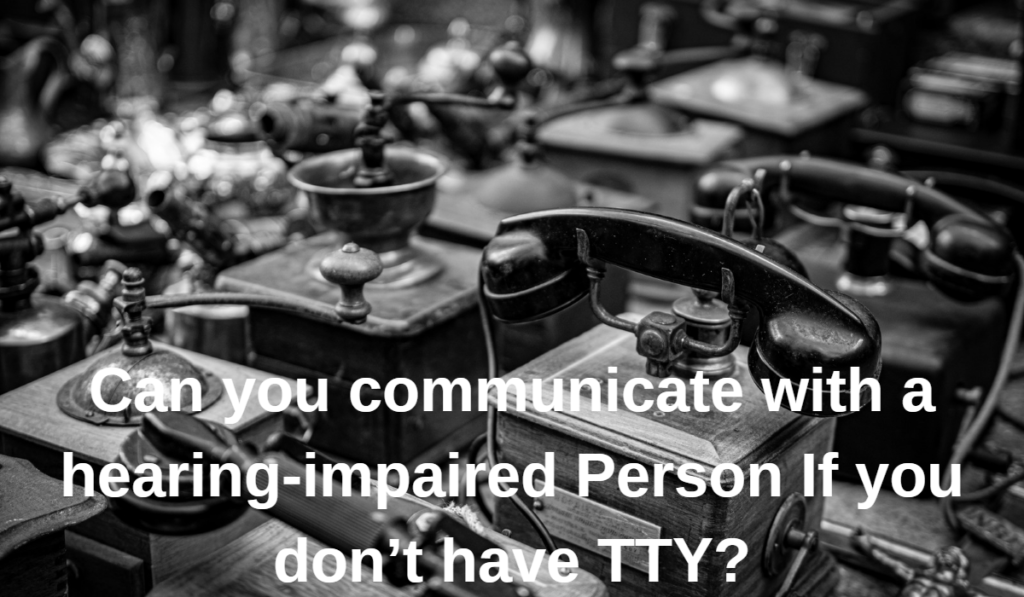
The meaning of TTY mode refers to a teletypewriter terminal, a type of device that allows users to communicate with a computer system. It was used for communication between teleprinters and computers, but it has evolved over time to include a variety of other functions, such as allowing disabled individuals to communicate with computers through an external device.
Do you need to use TTY mode? It depends on your specific needs. If you are deaf or hard of hearing, or if you are impaired, you may need to use TTY mode to communicate with your phone or computer. If you are in an environment where a loud noise would interfere with your communication, you may also want to use TTY mode. If you do not have any of these needs, you may not need to use TTY mode at all.
The meaning of TTY mode is a terminal for communicating with computers, and whether you need to use it depends on your specific needs and circumstances.
What is TeleTypeWriter?
The meaning of TTY mode is closely tied to the concept of a TeletypeWriter, known as a TTY. A TTY was originally a mechanical device that allowed users to send and receive messages through a computer system. It consisted of a keyboard for input and a printer for output, and it was typically used for communication between teleprinters and computers.
As technology evolved, TTYs became electronic devices and the term was expanded to include other types of terminals as well. The meaning of TTY mode often refers to a mode on a computer or mobile device that allows for communication through an external TTY or other similar device. This mode is often used by individuals who are deaf, hard of hearing, or visually impaired, as it allows them to communicate with the device using a keyboard or other input device.
How Does TTY Work?
The meaning of TTY mode is associated with the way TTY devices work to facilitate communication between individuals and computer systems. TTY devices use a combination of text and visual displays to enable communication, either through a direct connection to a computer or through a phone line.
In TTY mode, the device uses a special protocol to send and receive messages. The protocol includes specific characters and control codes that are used to format the text in a way that can be interpreted by the receiving device. The TTY device includes a special modem that is used to translate the digital signals from the computer into audible tones that can be transmitted over a phone line.
The TTY mode on a computer or mobile device works similarly, allowing individuals to communicate with the device using an external TTY or similar device. The device uses a special interface to translate the input from the external device into text that can be displayed on the screen. The device may include features such as automatic text-to-speech conversion for individuals who are deaf or hard of hearing.
How to use TTY Mode?

The meaning of TTY mode refers to a mode on a mobile phone or computer that allows individuals to communicate with the device using an external TTY or similar device. Using TTY mode is typically a simple process, but it may vary slightly depending on the device you are using.
You will first need to connect your TTY device to your phone or computer. On a mobile phone, this may involve connecting the TTY device to the phone’s headphone jack or using Bluetooth to connect wirelessly. On a computer, you may need to connect the TTY device to the computer using a USB or serial cable.
Once the TTY device is connected, you will need to enable TTY mode on your phone or computer. This can usually be done in the device’s settings, under the accessibility or telecommunication options. Once TTY mode is enabled, you should be able to start communicating with the device using the TTY device.
It is important to note that you may need to configure some settings on your TTY device, such as the baud rate or flow control, to ensure it is compatible with your phone or computer.You may need to adjust the settings on your phone or computer to ensure that it can communicate with the TTY device.
The Four settings:
The meaning of TTY mode is closely related to the four settings that are associated with this mode on a mobile phone or computer. These four settings are the TTY type, transmission speed, flow control, and parity.
The TTY type refers to the type of TTY device that you are using to communicate with your phone or computer. There are several different types of TTY devices, including full-duplex TTYs, half-duplex TTYs, and vibrating TTYs. The TTY type setting on your phone or computer should be set to match the type of TTY device you are using.
The transmission speed setting refers to the speed at which data is transmitted between your phone or computer and the TTY device. This setting should be set to match the speed of the TTY device, which is typically either 45.45 baud or 50 baud.
The flow control setting refers to the method used to control the flow of data between the phone or computer and the TTY device. There are several different flow control methods, including hardware flow control, software flow control, and no flow control. The flow control setting should be set to match the method used by the TTY device.
Can you communicate with a hearing-impaired Person If you don’t have TTY?

While the meaning of TTY mode refers to a mode that is designed to allow individuals to communicate with hearing-impaired individuals, it is not the only way to communicate with someone who is hearing-impaired. There are several alternative methods that can be used to communicate with a hearing-impaired person, even if you do not have access to a TTY device.
One alternative method is to use a video relay service (VRS). A VRS allows individuals to communicate with a hearing-impaired person using sign language, with the help of a sign language interpreter. VRS can be accessed through a computer, tablet, or smartphone, and it does not require a TTY device.
Another alternative method is to use an instant messaging app or text messaging service. Many instant messaging apps and text messaging services have built-in features that allow individuals to communicate in real-time using text, even if one of the parties is hearing-impaired.
Frequently Ask Questions
Is TTY mode supposed to be on?
Whether the meaning of TTY mode should be on or not depends on the individual’s needs and circumstances.
If an individual is deaf, hard-of-hearing, or has a speech disability, TTY mode may be necessary for them to communicate over a phone line. In this case, the TTY mode should be turned on.
If an individual does not have a hearing or speech disability, they may not need to use TTY mode. TTY mode can be turned off.
It is important to note that some emergency services, such as 911, may not be able to receive TTY calls. It may be necessary to use a different form of communication, such as a relay service or Video Relay Service (VRS).
Which TTY mode should I use?
The choice of which TTY mode to use depends on several factors, including the type of TTY device you have, the transmission speed of the device, and the flow control and parity settings of the device.
When choosing a TTY mode, it is important to ensure that the mode you choose is compatible with the type of TTY device you have. For example, if you have a full-duplex TTY device, you should choose a TTY mode that is designed for use with full-duplex TTYs.
It is important to consider the transmission speed of the TTY device when choosing a TTY mode. The transmission speed setting on your phone or computer should match the speed of the TTY device. If the speed setting on your phone or computer is higher or lower than the speed of the TTY device, the transmission may be disrupted or garbled.